The Vacuum Concentrators Market is estimated to be valued at USD 1.4 billion in 2025 and is projected to reach USD 2.4 billion by 2035, registering a compound annual growth rate (CAGR) of 5.4% over the forecast period.
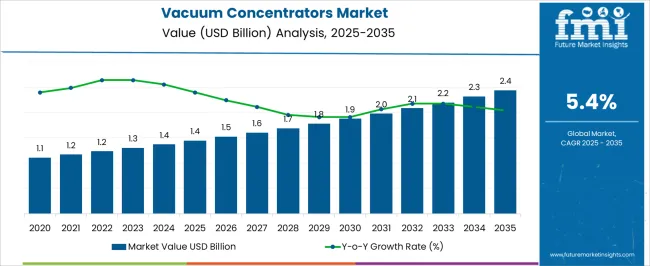
| Metric | Value |
|---|---|
| Vacuum Concentrators Market Estimated Value in (2025 E) | USD 1.4 billion |
| Vacuum Concentrators Market Forecast Value in (2035 F) | USD 2.4 billion |
| Forecast CAGR (2025 to 2035) | 5.4% |
The Vacuum Concentrators market is witnessing steady growth driven by the increasing demand for efficient solvent evaporation and sample concentration in laboratory and pharmaceutical workflows. The market is shaped by the need for high-throughput and precise sample handling, which is critical for analytical laboratories, pharmaceutical development, and life sciences research.
Advancements in laboratory automation and the integration of intelligent control systems have enhanced the operational efficiency of vacuum concentrators, enabling faster drying times, reduced energy consumption, and improved reproducibility. The rising number of research laboratories and expanding pharmaceutical manufacturing activities in both developed and emerging regions are further supporting market growth.
Additionally, the trend toward miniaturization and compact laboratory equipment has created opportunities for versatile and space-saving vacuum concentrators As laboratories increasingly adopt automated and integrated workflows, the demand for reliable, high-performance vacuum concentrators is expected to remain strong, providing sustained growth prospects across multiple end-use applications.
The vacuum concentrators market is segmented by equipment type, sales channel, end use, enterprise size, and geographic regions. By equipment type, vacuum concentrators market is divided into Speedvac Vacuum Concentrator, Individual Vacuum Concentrators, Refrigerated Centrivap Vacuum Concentrators, Centrivap Benchtop Vacuum Concentrators, Centrifugal Vacuum Concentrator, Micro Ir Vacuum Concentrator, and Others. In terms of sales channel, vacuum concentrators market is classified into Distributors, Original Equipment Manufacturers, and Online Stores. Based on end use, vacuum concentrators market is segmented into Pharmaceutical, Energy And Utility, Healthcare, Manufacturing, and Others. By enterprise size, vacuum concentrators market is segmented into Large Enterprise and Smes. Regionally, the vacuum concentrators industry is classified into North America, Latin America, Western Europe, Eastern Europe, Balkan & Baltic Countries, Russia & Belarus, Central Asia, East Asia, South Asia & Pacific, and the Middle East & Africa.
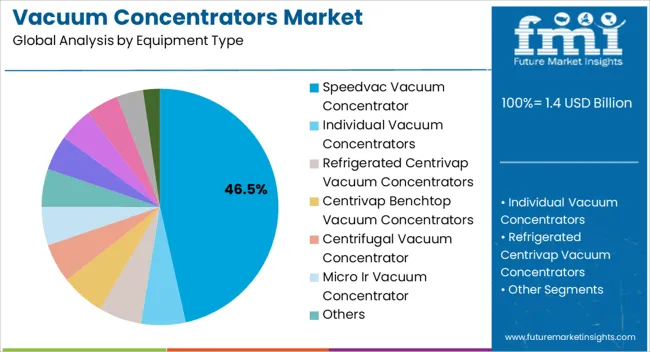
The SpeedVac Vacuum Concentrator is projected to hold 46.50% of the overall market revenue in 2025, making it the leading equipment type. This segment’s dominance is being attributed to its ability to rapidly concentrate samples while maintaining molecular integrity, which is critical for sensitive biological and chemical analyses.
The growing adoption has been driven by its compatibility with a wide range of laboratory workflows, including protein, DNA, and RNA sample preparation, as well as pharmaceutical research applications. Its compact design and ease of integration into automated laboratory setups have further reinforced its market position.
Additionally, the ability to handle multiple samples simultaneously and deliver precise temperature and vacuum control has made it a preferred choice for research and production laboratories The continued demand for high-throughput laboratory operations and the increasing focus on reducing sample processing time are expected to sustain the growth of the SpeedVac Vacuum Concentrator segment in the coming years.
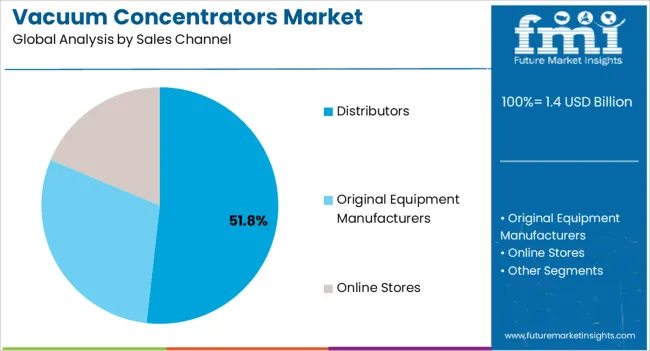
The distributors sales channel segment is expected to capture 51.80% of total market revenue in 2025, emerging as the dominant route for vacuum concentrator procurement. This preference has been driven by distributors’ extensive networks and their ability to provide timely delivery, technical support, and after-sales services to end-users across multiple regions.
The growth of this channel is being supported by its capacity to offer a variety of equipment options under one network, enabling laboratories and pharmaceutical companies to choose the most suitable products based on their specific operational requirements. Distributors also facilitate maintenance contracts, training, and installation support, which reduces operational risk for buyers.
The convenience of localized service and immediate product availability has reinforced the distributors channel as the primary procurement route As the demand for vacuum concentrators continues to rise across research and pharmaceutical sectors, this channel is expected to maintain its leadership due to its reliability, service quality, and extensive reach.
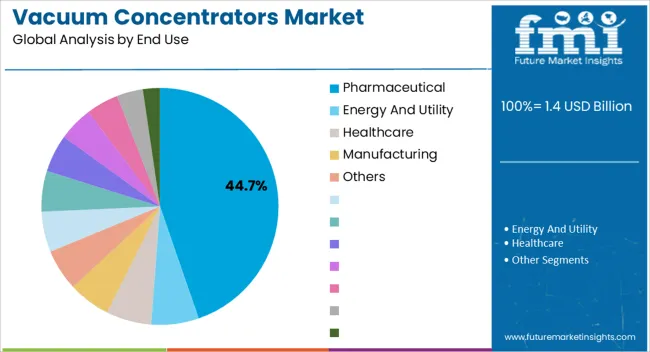
The pharmaceutical end-use segment is projected to hold 44.70% of the vacuum concentrators market revenue in 2025, representing the largest application sector. This leadership has been driven by the increasing use of vacuum concentrators in drug development, formulation studies, and high-throughput screening processes, where precise solvent removal and sample concentration are critical.
The segment’s growth is being fueled by rising pharmaceutical R&D expenditures, expansion of biopharmaceutical manufacturing, and adoption of automated and integrated laboratory systems. Vacuum concentrators offer the capability to handle sensitive compounds without degradation, ensuring reliability and reproducibility of experimental results.
Additionally, compliance with regulatory standards and quality control processes in pharmaceutical laboratories has necessitated the use of high-performance concentrators As the pharmaceutical industry continues to expand globally and invest in advanced laboratory infrastructure, the demand for vacuum concentrators in this sector is expected to sustain its leading position, providing opportunities for continued innovation and adoption.
The field of vacuum technologies is getting more advanced, as a lot of research regarding the same is being carried on. The use of vacuum concentrators in laboratories is growing significantly. A vacuum concentrator is a laboratory equipment that uses a combination of vacuum, heat, and centrifugal force for rapid evaporation of multiple small samples.
Sample sizes may vary from a few microliters to upto 25 milliliters. A vacuum concentrator is used in various industries like biology, biochemistry, pharmaceutical research, and microbiology, thereby providing growth opportunities to the market.
vacuum concentrator finds applications in analytical chemistry laboratories as well. A vacuum concentrator is provided with cold traps to protect it from corrosive chemicals. Vacuum concentrators are used for concentrating solutes from a liquid sample into a dry state or a wet-pelleted state.
A laboratory concentrator has wide applications in the field of research and development in the healthcare vertical as well. A vacuum concentrator is used to concentrate DNA, RNA, and also to evaporate liquids.
The concentration of proteins can also be achieved with the help of vacuum concentrators. Vacuum concentrators are differentiated on the basis of features such as heating capacity, gas blow down, time setting, and noise level.
Also, beneficial features such as, prevention of cross-contamination, cost-effectiveness, and ease of use, ensure the potential growth of the vacuum concentrator market during the forecast period.
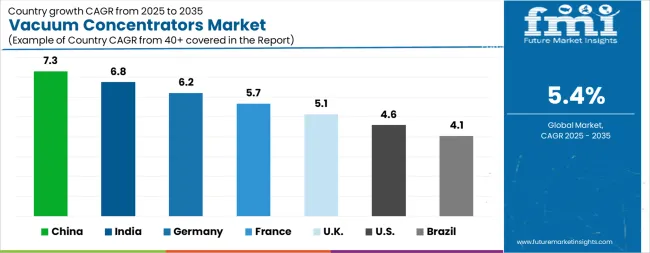
| Country | CAGR |
|---|---|
| China | 7.3% |
| India | 6.8% |
| Germany | 6.2% |
| France | 5.7% |
| UK | 5.1% |
| USA | 4.6% |
| Brazil | 4.1% |
The Vacuum Concentrators Market is expected to register a CAGR of 5.4% during the forecast period, exhibiting varied country level momentum. China leads with the highest CAGR of 7.3%, followed by India at 6.8%. Developed markets such as Germany, France, and the UK continue to expand steadily, while the USA is likely to grow at consistent rates. Brazil posts the lowest CAGR at 4.1%, yet still underscores a broadly positive trajectory for the global Vacuum Concentrators Market. In 2024, Germany held a dominant revenue in the Western Europe market and is expected to grow with a CAGR of 6.2%. The USA Vacuum Concentrators Market is estimated to be valued at USD 504.0 million in 2025 and is anticipated to reach a valuation of USD 789.5 million by 2035. Sales are projected to rise at a CAGR of 4.6% over the forecast period between 2025 and 2035. While Japan and South Korea markets are estimated to be valued at USD 77.9 million and USD 44.4 million respectively in 2025.
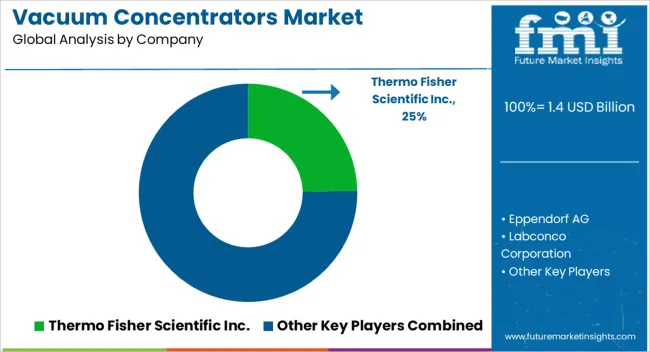
| Item | Value |
|---|---|
| Quantitative Units | USD 1.4 Billion |
| Equipment Type | Speedvac Vacuum Concentrator, Individual Vacuum Concentrators, Refrigerated Centrivap Vacuum Concentrators, Centrivap Benchtop Vacuum Concentrators, Centrifugal Vacuum Concentrator, Micro Ir Vacuum Concentrator, and Others |
| Sales Channel | Distributors, Original Equipment Manufacturers, and Online Stores |
| End Use | Pharmaceutical, Energy And Utility, Healthcare, Manufacturing, and Others |
| Enterprise Size | Large Enterprise and Smes |
| Regions Covered | North America, Europe, Asia-Pacific, Latin America, Middle East & Africa |
| Country Covered | United States, Canada, Germany, France, United Kingdom, China, Japan, India, Brazil, South Africa |
| Key Companies Profiled | Thermo Fisher Scientific Inc., Eppendorf AG, Labconco Corporation, Buchi Labortechnik AG, Martin Christ Gefriertrocknungsanlagen GmbH, Savant Instruments, SP Scientific, Genevac Ltd., LabTech S.r.l., Hettich Instruments, and IKA Works, Inc. |
The global vacuum concentrators market is estimated to be valued at USD 1.4 billion in 2025.
The market size for the vacuum concentrators market is projected to reach USD 2.4 billion by 2035.
The vacuum concentrators market is expected to grow at a 5.4% CAGR between 2025 and 2035.
The key product types in vacuum concentrators market are speedvac vacuum concentrator, individual vacuum concentrators, refrigerated centrivap vacuum concentrators, centrivap benchtop vacuum concentrators, centrifugal vacuum concentrator, micro ir vacuum concentrator and others.
In terms of sales channel, distributors segment to command 51.8% share in the vacuum concentrators market in 2025.






Our Research Products

The "Full Research Suite" delivers actionable market intel, deep dives on markets or technologies, so clients act faster, cut risk, and unlock growth.

The Leaderboard benchmarks and ranks top vendors, classifying them as Established Leaders, Leading Challengers, or Disruptors & Challengers.

Locates where complements amplify value and substitutes erode it, forecasting net impact by horizon

We deliver granular, decision-grade intel: market sizing, 5-year forecasts, pricing, adoption, usage, revenue, and operational KPIs—plus competitor tracking, regulation, and value chains—across 60 countries broadly.

Spot the shifts before they hit your P&L. We track inflection points, adoption curves, pricing moves, and ecosystem plays to show where demand is heading, why it is changing, and what to do next across high-growth markets and disruptive tech

Real-time reads of user behavior. We track shifting priorities, perceptions of today’s and next-gen services, and provider experience, then pace how fast tech moves from trial to adoption, blending buyer, consumer, and channel inputs with social signals (#WhySwitch, #UX).

Partner with our analyst team to build a custom report designed around your business priorities. From analysing market trends to assessing competitors or crafting bespoke datasets, we tailor insights to your needs.
Supplier Intelligence
Discovery & Profiling
Capacity & Footprint
Performance & Risk
Compliance & Governance
Commercial Readiness
Who Supplies Whom
Scorecards & Shortlists
Playbooks & Docs
Category Intelligence
Definition & Scope
Demand & Use Cases
Cost Drivers
Market Structure
Supply Chain Map
Trade & Policy
Operating Norms
Deliverables
Buyer Intelligence
Account Basics
Spend & Scope
Procurement Model
Vendor Requirements
Terms & Policies
Entry Strategy
Pain Points & Triggers
Outputs
Pricing Analysis
Benchmarks
Trends
Should-Cost
Indexation
Landed Cost
Commercial Terms
Deliverables
Brand Analysis
Positioning & Value Prop
Share & Presence
Customer Evidence
Go-to-Market
Digital & Reputation
Compliance & Trust
KPIs & Gaps
Outputs
Full Research Suite comprises of:
Market outlook & trends analysis
Interviews & case studies
Strategic recommendations
Vendor profiles & capabilities analysis
5-year forecasts
8 regions and 60+ country-level data splits
Market segment data splits
12 months of continuous data updates
DELIVERED AS:
PDF EXCEL ONLINE
Vacuum Products for Emergency Services Market Size and Share Forecast Outlook 2025 to 2035
Vacuum Fiber Feedthrough Flanges Market Size and Share Forecast Outlook 2025 to 2035
Vacuum Tension Rolls Market Size and Share Forecast Outlook 2025 to 2035
Vacuum Self-priming Mobile Pumping Station Market Size and Share Forecast Outlook 2025 to 2035
Vacuum Skin Packaging Market Size and Share Forecast Outlook 2025 to 2035
Vacuum-Refill Units Market Analysis - Size and Share Forecast Outlook 2025 to 2035
Vacuum Leak Detectors Market Size and Share Forecast Outlook 2025 to 2035
Vacuum Insulation Panels Market Size and Share Forecast Outlook 2025 to 2035
Vacuum Pressure Encapsulated Transformer Market Size and Share Forecast Outlook 2025 to 2035
Vacuum Insulated Medium Voltage Switchgear Market Size and Share Forecast Outlook 2025 to 2035
Vacuum Rated Motors Market Size and Share Forecast Outlook 2025 to 2035
Vacuum Insulated Low Voltage Commercial Switchgear Market Size and Share Forecast Outlook 2025 to 2035
Vacuum Pressure Impregnated (VPI) Transformer Market Size and Share Forecast Outlook 2025 to 2035
Vacuum Insulated Pipe Market Size and Share Forecast Outlook 2025 to 2035
Vacuum Therapy Devices Market Size and Share Forecast Outlook 2025 to 2035
Vacuum Pressure Swing Adsorption Market Size and Share Forecast Outlook 2025 to 2035
Vacuum Grease Market Size and Share Forecast Outlook 2025 to 2035
Vacuum Truck Market Size and Share Forecast Outlook 2025 to 2035
Vacuum Thermoformed Packaging Market Size and Share Forecast Outlook 2025 to 2035
Vacuum Insulated Switchgear Market Size and Share Forecast Outlook 2025 to 2035

Thank you!
You will receive an email from our Business Development Manager. Please be sure to check your SPAM/JUNK folder too.
Chat With
MaRIA